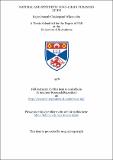Files in this item
Natural and synthetic long-chained furanoid acids
Item metadata
| dc.contributor.advisor | Gunstone, F. D. | |
| dc.contributor.author | Wijesundera, Rajendranath Chakrapani | |
| dc.coverage.spatial | xvi, 310 p. | en_US |
| dc.date.accessioned | 2018-07-12T15:08:15Z | |
| dc.date.available | 2018-07-12T15:08:15Z | |
| dc.date.issued | 1978 | |
| dc.identifier.uri | https://hdl.handle.net/10023/15320 | |
| dc.description.abstract | Fatty acids containing a furan ring system were recently discovered by North American Scientists in the liver and testicular lipids of northern pike. We developed an analytical procedure based on urea crystallization and argentation thin layer chromatography for the isolation of small quantities of these novel acids. Using this method a large number of fish lipids taken from both freshwater and marine habitats wore examined. Our results show the wide occurrence of furanoid acids in fish at a low level (up to 5%), These unusual acids tend to concentrate in the cholesterol esters and appear to be absent from the phospholipids. Contrary to claims by the North American researchers we do not find a significant relation between the occurrence of these acids and the sex of the species or on whether the lipid is derived from a freshwater or marine source. We consider rather that the nutritional status of the animal is more significant. Cod liver oil usually contains furanoid acids at about 1% level but in two starved cod the proportion of these acids rose dramatically to 34 and 48% respectively. We also examined four commercial fish meals but furanoid acids were not present in any of them. Furanoid fatty acids were found to accumulate in the adipose tissue of rats given cod liver oil. No furanoid acids were demonstrable in comparable samples from rats given synthetic 10,13-furan acid. A furanoid fatty acid has been isolated from Exocarpus cupressiformis seed oil. In two samples of this seed available to us we did not detect any furanoid acids but found 8-hydroxyoctadoc-trans-11-en-9-noic acid (5%).The methodology used in the isolation of furanoid acids also allowed the study of methyl-branched acids. Whilst confirming the wide distribution of three phytol-based acids in fish lipids we have also detected three other compounds which we believe are diunsaturated derivatives of 7,9-dimethylhexadecanoic, 7,9- and 9,11-dimethyloctadecanoic acids respectively. The opportunity was also taken to study the more common acids of some fish species not previously examined. Besides confirming the well-known differences between the lipids of freshwater and marine origin, we find a significant difference between the fatty acids of male and female fish of freshwater origin, with the female containing more n-3 polyene acids and less monoene acids than does the male. The n-3/n-6 ratio is the most significant feature distinguishing freshwater from marine fish lipids. The 10,13-, 9,12-, and 8,11-isomers of the C₁₈ furanoid acids were prepared by one or more of the following methods. (i) Pd(II)-catalysed cyclodehydrogenation of oxygen-containing unsaturated acids, (ii) dehydration of diepoxides and dehydrogenation of epoxy alkenes with propyl iodide-sodium iodide-dimethylsulphoxide, and (iii) dehydration of endoperoxides. Synthesis of heterocyclic compounds by Pd(II)-promoted cyclization reactions is a fairly new development. The reactivity of various long-chain oxygenated esters with this unique reagent is discussed. The endoperoxide route is also novel and leads to speculation about the biosynthesis of natural furanoid acids. Recognition and identification of long-chain furanoid acids by their chromatographic and spectroscopic behaviour is discussed. Mass spectrometry is a powerful method of structure determination of these substances. Some chemical reactions of long-chain furanoid acids are also described. | en_US |
| dc.language.iso | en | en_US |
| dc.publisher | University of St Andrews | |
| dc.subject.lcc | QD405.W5 | |
| dc.subject.lcsh | Furans | en |
| dc.title | Natural and synthetic long-chained furanoid acids | en_US |
| dc.type | Thesis | en_US |
| dc.contributor.sponsor | Commonwealth Scholarship Commission in the United Kingdom | en_US |
| dc.type.qualificationlevel | Doctoral | en_US |
| dc.type.qualificationname | PhD Doctor of Philosophy | en_US |
| dc.publisher.institution | The University of St Andrews | en_US |
This item appears in the following Collection(s)
Items in the St Andrews Research Repository are protected by copyright, with all rights reserved, unless otherwise indicated.

